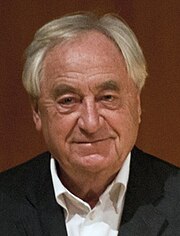Cees Nooteboom's Human Design Chart
1/3 Sacral GeneratorDutch writer of novels, travel literature, poetry and journalist.
Noorteboom’s father Hubertus Maria Nooteboom (13 February 1897, Den Haag, 17 March, Voorburg) was a merchant. He married the much younger Johanna Carolina Christina Sophia Pessers (29 December 1910, Tilburg – 7 January 2008, Loon op Zand). The family moved a lot. In the seven years before the war broke out he lived on seven addresses in Den Haag and Rijswijk. With his father, he watched the bombardment of airport Ypenburg by the Germans on 10 May 1940. On 5 Augustus 1943 his father left the family, on 28 March 1944 he divorced and on 3 March 1945 he got severely wounded during the Bombing of the Bezuidenhout. The targets of the the allied forces were V2-launching sites, but the 67 tonnes of brisant bombs fell on on a not yet evacuated part of Den Haag. As fire engines and firemen had been sent to Germany, the resulting fire was unchecked, killing 511 people.
After the war there followed again a lot of moves of house. For details see the DBNL. In 1948 his mother remarried a very strict Catholic. Nooteboom was sent to of Franciscan and Augustinian monastery schools. He was bright enough for the Gymnasium, but he attended four of them, without attaching to really one of them and without getting ever the desired diploma. In 1951 he left home after an argument with his stepfather. He got a job as bank clerk in Hilversum , but still studied in the evening for the Lyceum diploma.
In 1953, after being rejected for the Dutch military service as too meagre (1952), Nooteboom started to travel abroad, typically by hitch-hiking in Scandinavia and France, as he had little money. He met his travelling friend, the half Jewish Dutch photographer Philip Mechanicus (13 Augustus 1936, A’dam – 30 July 2005, A’dam) in Paris. In 1954 he started writing his début novel “Philip en de anderen” (Philip and the others) that appeared in 1955. Together with Harry Mulisch, a friend and opponent, he got the first 1957 Anne Frank Prize for it on 12 February 1958. Mulisch got it for his debut “Archibald Strohalm”.
In 1955 he moved to Amsterdam and became a journalist for “Het vrije volk”. For the newspaper “Het Parool he reported on the Hungarian Revolution of 1956 and in Elseviers Weekblad he published his first travelling stories in 1957.
In 1956 he published his first poetry bundle “De doden zoeken een huis” (The Dead Seek a Home). The often travelling main characters in his works often feel displaced and alienated from their surrounding. They are outsiders, who are struggling to get a grip on reality as reality and fiction become increasingly intertwined. Like the work of his friend Mulisch, Nooteboom’s novels often have a double or triple layers and multiple dimensions in space and time.
The man who could not finish his study because of frequent moves in his youth, is now seen as the best Dutch writer of travelling stories ever. His novel Rituelen (Rituals) of 1980, is seen as his best literary work. It gave him international recognition, many awards, and was filmed in 1989 with Thom Hoffman, Derek de Lint and Ton Lensink.
During the fall of the Berlin wall he wrote “Berlijnse notities”. With the novel “Het volgende verhaal (1991; Die folgende Geschichte)he became more famous in Germany then in the Netherlands. It is not uncommon that German translations appeared earlier then the Dutch version.
Personal.
Autumn 1957 he married in New York Frances “Fanny” Diana Lichtveld without consent of her father. Witnesses were his nephew Guus Nooteboom and the poet and biologist Leo Vroman. They divorced in 1964. From 1965 till 1979 he had a relation with Elisabeth Dorothea Driessen (12 December 1941, Bandoeng), better known under her artist name Liesbeth List. Since 1979 he had a relation with his current partner the photographer Simone Sassen (1952, Roermond). Since 1989 lives Cees Nooteboom – between his travels – in the Netherlands, Germany and Spain.
Link to Wikipidia biography
Discover More Famous People
Browse and analyze over 55,000 public figures and celebrities.
Ra Uru Hu
5/1 Manifestor
Martha Stewart
4/6 Manifestor
David Lynch
4/6 Generator
Barack Obama
6/2 Projector
Steve Jobs
6/3 Generator
Vladimir Putin
5/1 Manifestor
Kim Kardashian
3/5 Generator
Michael Jackson
1/3 Projector
Marilyn Monroe
6/2 Projector
Ariana Grande
2/4 Projector
Oprah Winfrey
2/4 Generator
Johnny Depp
2/4 ManifestorWhat is HumanDesign.ai and how does it work?
Curious what makes Cees Nooteboom tick? HumanDesign.ai instantly maps their exact birth data into a fully interactive clickable bodygraph chart, letting you hover or tap every center, channel, and gate for plain-language explanations. Bella, the platform’s built-in AI guide, adds context in real time, translating complex mechanics into everyday insights so you can see how Cees Nooteboom’s strengths, challenges, and life themes play out on-screen.
The same tools are waiting for you. Generate your own Human Design Chart in seconds, open a library of 2000+ suggested questions, and chat with Bella as often as you like to decode your design, daily transits, and even relationship dynamics.
Want to compare energies? Save unlimited charts for friends, family, or clients, then ask Bella to reveal compatibilities, composite patterns, or coaching tips, all in one conversation thread.
Start free with core features, or unlock our Personal and Pro plans for deeper dives: unlimited Q&A, celebrity chart search spanning 55,000+ public figures, white-label PDF reports, branded content generation, and a professional profile with built-in booking for practitioners. Whether you’re exploring your own potential or guiding others, HumanDesign.ai delivers an ever-expanding toolbox of AI-powered insights—no spreadsheets, no jargon, just clarity at your fingertips.
Ready to see yours? Signup for FREE today!

